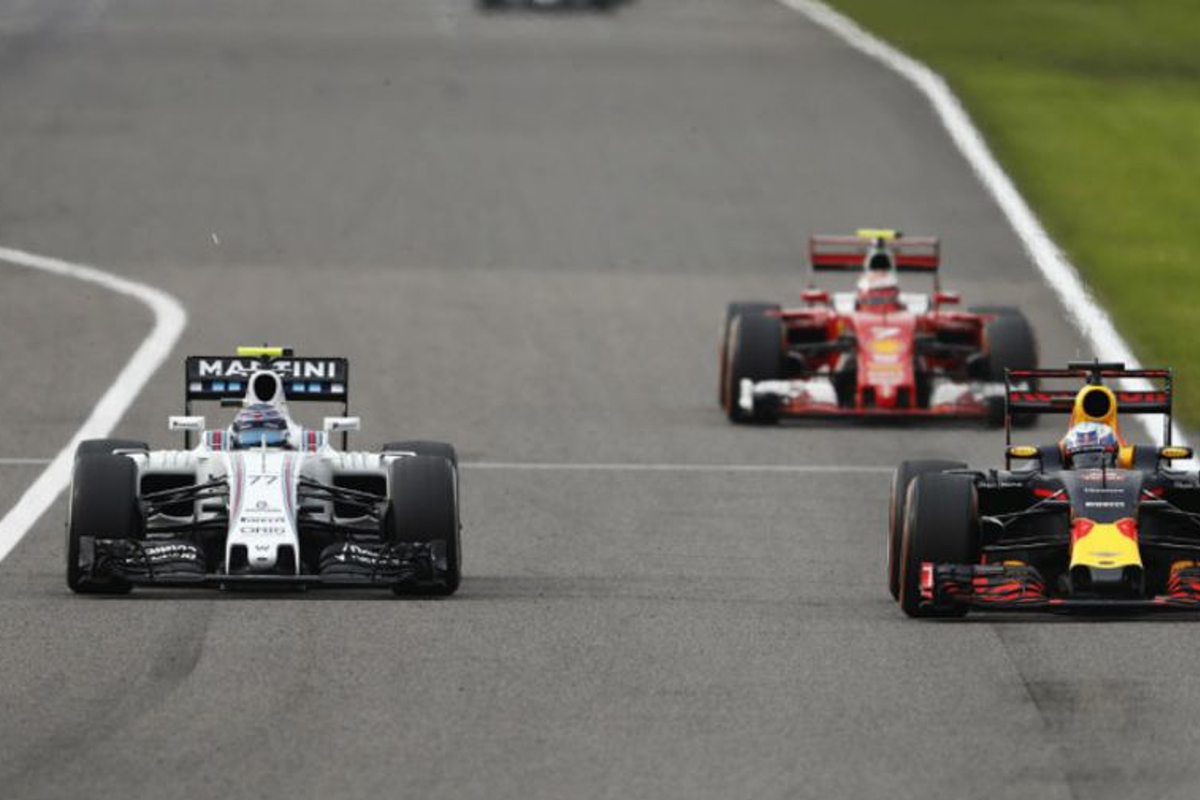
F1 Explained: What is DRS? Why does it help overtaking?
F1 Explained: What is DRS? Why does it help overtaking?

There are few greater thrills in motor racing than watching one car overtake another, whether diving down the inside, or sailing the long way around. Formula 1 has a special system in place to encourage on-track action. But what is the 'DRS', and how does it work? Here's everything you need to know.
WHAT IS DRS?
The Drag Reduction System, or DRS, was introduced into F1 in 2011 to boost flagging numbers of overtakes. Sections of the track, usually the pit straight and one other area, are designated to using the DRS - where overtakes become more likely. If a driver is within a second of the car ahead while passing the 'detection' point, they can use DRS once they are in the 'activation' zone.

HOW DOES DRS WORK?
Once activated, the DRS lifts a section of a car's rear wing, creating an opening that air can rush through. This reduces the aerodynamic drag of a car - its resistance to the air - and will give it a boost of extra speed.
It is estimated that cars will gain an extra 10mph through a DRS zone, helping to nudge ahead.
DOES DRS = MORE EXCITEMENT?
It depends on your view! In theory, more overtaking means a more exciting race. However, overtakes aided by DRS don't tend to be as dramatic as some of the more famous manoeuvres, where the drivers' skill and bravery is truly put to the test. Watching a car blast past another before the braking zone does not always get the pulse racing in the same way, unfortunately.
HAS OVERTAKING GONE UP?
Yes and no. Overtaking manoeuvres shot up once DRS was introduced, but those numbers came crashing down again last year, when new regulations meant cars were wider and quicker in straight lines, making passing much more difficult. Statistics showed that overtakes were almost cut in half in 2017.
IS THERE A SOLUTION?
F1 has introduced a third DRS zone for the 2018 season-opening race in Melbourne. Only five overtakes were recorded at Albert Park in 2017, two of which came in one thrilling move involving Esteban Ocon, Nico Hulkenberg and Fernando Alonso. The plan is likely to be used in Sochi, too, where there was a solitary pass in 2017.
Change your timezone:
Latest News

Audi agree STAR driver contract as Mercedes driver tipped for new F1 seat THIS season - GPFans F1 Recap
- 2 hours ago

Ferrari show off new-look drivers following HUGE announcement
- 3 hours ago

McLaren leading fight for HUGE cash injection
- Yesterday 21:57

Newey set to announce STUNNING Red Bull departure
- Yesterday 17:57

Newey Red Bull exit wish CONFIRMED as F1 guru's reasons revealed
- Yesterday 20:57

F1 legend reveals 'FLOOD' of death threats after controversial decision
- Yesterday 19:57
F1 Standings

Drivers
- Oliver Bearman
- Charles Leclerc
- Carlos Sainz
- Lando Norris
- Oscar Piastri
- Pierre Gasly
- Esteban Ocon
- Sergio Pérez
- Max Verstappen
- Alexander Albon
- Logan Sargeant
- Lewis Hamilton
- George Russell
- Nico Hülkenberg
- Kevin Magnussen
- Fernando Alonso
- Lance Stroll
- Valtteri Bottas
- Zhou Guanyu
- Daniel Ricciardo
- Yuki Tsunoda
Races
-
 Gulf Air Grand Prix of Bahrain 2024
Gulf Air Grand Prix of Bahrain 2024
-
 Saudi Arabian Grand Prix 2024
Saudi Arabian Grand Prix 2024
-
 Grand Prix of Australia 2024
Grand Prix of Australia 2024
-
 MSC Cruises Grand Prix of Japan 2024
MSC Cruises Grand Prix of Japan 2024
-
 Grand Prix of China 2024
Grand Prix of China 2024
-
 Miami Grand Prix 2024
Miami Grand Prix 2024
-
 Gran Premio dell'Emilia Romagna 2024
Gran Premio dell'Emilia Romagna 2024
-
 Grand Prix of Monaco 2024
Grand Prix of Monaco 2024
-
 Grand Prix du Canada 2024
Grand Prix du Canada 2024
-
 Gran Premio de España 2024
Gran Premio de España 2024
-
 Grand Prix of Austria 2024
Grand Prix of Austria 2024
-
 Grand Prix of Great Britain 2024
Grand Prix of Great Britain 2024
-
 Grand Prix of Hungary 2024
Grand Prix of Hungary 2024
-
 Grand Prix of Belgium 2024
Grand Prix of Belgium 2024
-
 Heineken Dutch Grand Prix 2024
Heineken Dutch Grand Prix 2024
-
 Grand Prix of Italy 2024
Grand Prix of Italy 2024
-
 Grand Prix of Azerbaijan 2024
Grand Prix of Azerbaijan 2024
-
 Grand Prix of Singapore 2024
Grand Prix of Singapore 2024
-
 Grand Prix of the United States 2024
Grand Prix of the United States 2024
-
 Gran Premio de la Ciudad de Mexico 2024
Gran Premio de la Ciudad de Mexico 2024
-
 Grande Prêmio de São Paulo 2024
Grande Prêmio de São Paulo 2024
-
 Heineken Silver Las Vegas Grand Prix 2024
Heineken Silver Las Vegas Grand Prix 2024
-
 Qatar Grand Prix 2024
Qatar Grand Prix 2024
-
 Grand Prix of Abu Dhabi 2024
Grand Prix of Abu Dhabi 2024
About GPFans
GPFans is a multi-platform, multi-language brand dedicated to Formula One coverage. We bring you all the ins and outs of the sport, 24/7, everything from up-to-the-minute news and features to the latest viral stories and clips.We believe that a new generation of exciting, outspoken drivers will make F1 more popular than ever before, and we want to give our users access to as much of their heroes as possible, on and off the track. From Lewis Hamilton to Max Verstappen, Daniel Ricciardo to Sebastian Vettel, we provide in-depth analysis of every every Grand Prix in the season, from Australia to Abu Dhabi.
With Formula One under the new ownership of Liberty Media, how the sport is being covered is evolving, and GPFans will look to be at the heart of this progression into new media, as one of the fastest-growing sites covering the king of motorsports.
Follow us on your favorite social media channel
Corporate & Media
 Innovatieweg 20C
Innovatieweg 20C7007 CD, Doetinchem, Netherlands
+31645516860



















 Gulf Air Grand Prix of Bahrain 2024
Gulf Air Grand Prix of Bahrain 2024  Saudi Arabian Grand Prix 2024
Saudi Arabian Grand Prix 2024  Grand Prix of Australia 2024
Grand Prix of Australia 2024  MSC Cruises Grand Prix of Japan 2024
MSC Cruises Grand Prix of Japan 2024  Grand Prix of China 2024
Grand Prix of China 2024  Gran Premio dell'Emilia Romagna 2024
Gran Premio dell'Emilia Romagna 2024  Grand Prix of Monaco 2024
Grand Prix of Monaco 2024  Grand Prix du Canada 2024
Grand Prix du Canada 2024  Gran Premio de España 2024
Gran Premio de España 2024  Grand Prix of Austria 2024
Grand Prix of Austria 2024  Grand Prix of Hungary 2024
Grand Prix of Hungary 2024  Grand Prix of Belgium 2024
Grand Prix of Belgium 2024  Grand Prix of Azerbaijan 2024
Grand Prix of Azerbaijan 2024  Grand Prix of Singapore 2024
Grand Prix of Singapore 2024  Gran Premio de la Ciudad de Mexico 2024
Gran Premio de la Ciudad de Mexico 2024  Grande Prêmio de São Paulo 2024
Grande Prêmio de São Paulo 2024  Qatar Grand Prix 2024
Qatar Grand Prix 2024  Grand Prix of Abu Dhabi 2024
Grand Prix of Abu Dhabi 2024